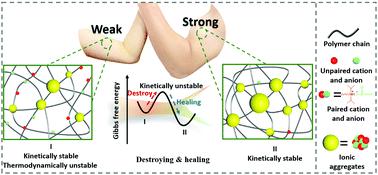当前位置:
X-MOL 学术
›
Mater. Horiz.
›
论文详情
Our official English website, www.x-mol.net, welcomes your
feedback! (Note: you will need to create a separate account there.)
Thermal and mechanical activation of dynamically stable ionic interaction toward self-healing strengthening elastomers
Materials Horizons ( IF 12.2 ) Pub Date : 2021-07-16 , DOI: 10.1039/d1mh00638j Yan Peng 1 , Yujia Hou 1 , Qi Wu 1 , Qichao Ran 1 , Guangsu Huang 1 , Jinrong Wu 1
Materials Horizons ( IF 12.2 ) Pub Date : 2021-07-16 , DOI: 10.1039/d1mh00638j Yan Peng 1 , Yujia Hou 1 , Qi Wu 1 , Qichao Ran 1 , Guangsu Huang 1 , Jinrong Wu 1
Affiliation

|
Biological tissues can grow stronger after damage and self-healing. However, artificial self-healing materials usually show decreased mechanical properties after repairing. Here, we develop a self-healing strengthening elastomer (SSE) by engineering kinetic stability in an ionomer. Such kinetic stability is enabled by designing large steric hindrance on the cationic groups, which prevents the structural change driven by thermodynamic instability under room temperature. However, once heat or external force is applied to disrupt the kinetic stability, the inherent thermodynamic instability induces the SSEs to form bigger and denser aggregates, thereby the material becomes stronger during the healing process. Consequently, the self-healing efficiency of fractured SSEs is as high as 143%. Unlike conventional ionomers whose mechanical properties change with time uncontrollably due to the thermodynamic instability, the SSEs show tunable self-healing strengthening behavior, thanks to the kinetic stability. This work provides a novel and universal strategy to fabricate biomimetic self-healing strengthening materials.
中文翻译:

动态稳定离子相互作用对自修复增强弹性体的热和机械活化
生物组织在损伤和自愈后会变得更强壮。然而,人工自愈材料在修复后通常表现出力学性能下降。在这里,我们通过设计离聚物的动力学稳定性来开发一种自修复强化弹性体 (SSE)。这种动力学稳定性是通过在阳离子基团上设计大的空间位阻来实现的,这可以防止在室温下由热力学不稳定性驱动的结构变化。然而,一旦施加热量或外力破坏动力学稳定性,固有的热力学不稳定性会导致 SSE 形成更大、更密集的聚集体,从而使材料在愈合过程中变得更强。因此,断裂 SSE 的自愈效率高达 143%。与由于热力学不稳定性而机械性能随时间不可控制地变化的传统离聚物不同,由于动力学稳定性,SSE表现出可调节的自愈强化行为。这项工作为制造仿生自愈强化材料提供了一种新颖且通用的策略。
更新日期:2021-07-27
中文翻译:

动态稳定离子相互作用对自修复增强弹性体的热和机械活化
生物组织在损伤和自愈后会变得更强壮。然而,人工自愈材料在修复后通常表现出力学性能下降。在这里,我们通过设计离聚物的动力学稳定性来开发一种自修复强化弹性体 (SSE)。这种动力学稳定性是通过在阳离子基团上设计大的空间位阻来实现的,这可以防止在室温下由热力学不稳定性驱动的结构变化。然而,一旦施加热量或外力破坏动力学稳定性,固有的热力学不稳定性会导致 SSE 形成更大、更密集的聚集体,从而使材料在愈合过程中变得更强。因此,断裂 SSE 的自愈效率高达 143%。与由于热力学不稳定性而机械性能随时间不可控制地变化的传统离聚物不同,由于动力学稳定性,SSE表现出可调节的自愈强化行为。这项工作为制造仿生自愈强化材料提供了一种新颖且通用的策略。











































 京公网安备 11010802027423号
京公网安备 11010802027423号